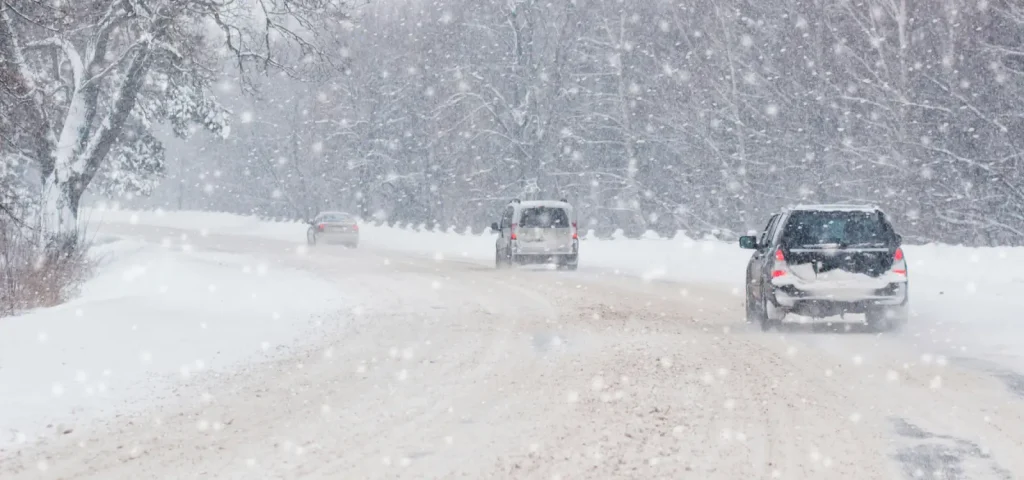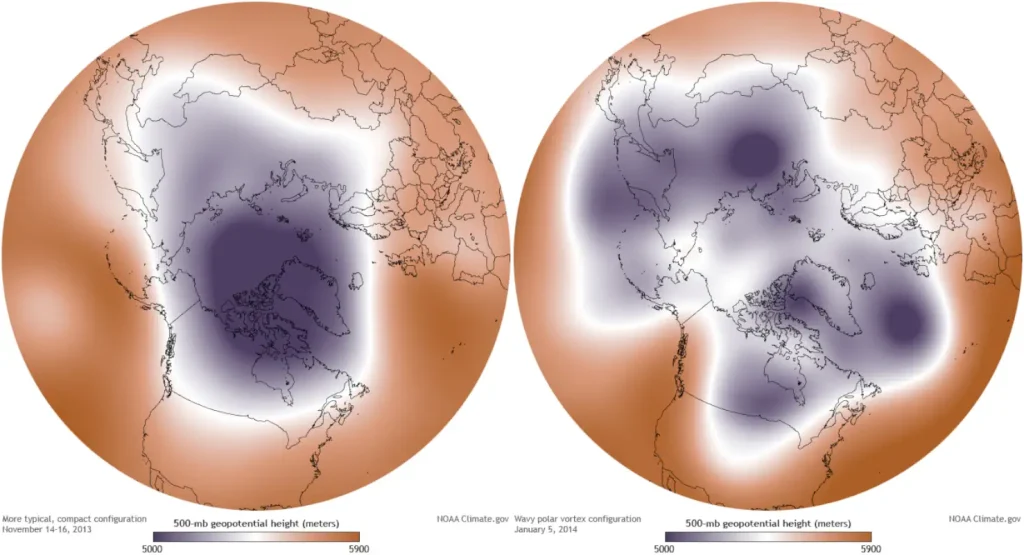Despite human-induced climate change (global warming), a seemingly paradoxical phenomenon has been observed: harsher winters in some regions. Central to understanding this phenomenon is the polar vortex, a vast whirlpool of cold air encircling the poles, strongest in winter. However, under the influence of global warming, this vortex can weaken and even collapse. This disruption, often driven by sudden stratospheric warming events and changes in atmospheric pressure systems, allows frigid Arctic air to spill southward, bringing unexpected and severe cold spells to mid-latitudes. Thus, while the planet warms overall, the effects of a destabilized polar vortex illustrate how climate change can lead to complex and counterintuitive weather patterns, including colder winters in some areas.
The Polar Vortex and its impact on winter weather
The polar vortex is a critical component in understanding complex weather patterns, particularly during the winter months. At its core, the polar vortex is a vast area of low pressure and cold air that consistently encircles the polar regions. Its presence is a permanent feature of our planet’s atmospheric system, but it undergoes significant changes in strength and definition with the changing seasons, becoming more pronounced during winter.
The vortex exists in the stratosphere, a layer of the atmosphere situated above the troposphere. The troposphere is the lowest layer of the atmosphere, where the weather as we experience it day-to-day occurs. The stratosphere, by contrast, lies above this, and it is in this higher atmospheric layer that the polar vortex holds sway.

One of the key roles of the polar vortex is to maintain the coldest air near the poles. This function is analogous to a refrigerator door: it keeps the cold air locked in at the poles. However, the vortex is not always stable. There are times when it weakens or even collapses, which has significant consequences for weather patterns further south.
When the polar vortex weakens, it can lose its grip on the polar air. This loss of containment allows the bitterly cold Arctic air to spill southward. This southward movement of cold air can lead to severe winter weather in parts of the United States, Canada, and Europe. Ironically, while these regions experience colder conditions due to a weakened polar vortex, the polar regions themselves can experience warmer than usual temperatures. This warming occurs because as the cold air moves south, warmer air from lower latitudes can move north to take its place.

Weakened (or even worse, collapsed) Polar Vortex means harsher winters
The phenomena of a collapsing or weakening polar vortex have historically triggered severe and prolonged bouts of cold weather. These events can have drastic impacts, ranging from devastating snowstorms to life-threateningly low temperatures. Notable recent occurrences include:
- In 2014, the United States endured a particularly harsh winter due to a weakened polar vortex, with temperatures in certain regions plummeting to 30-40 °F below their usual averages.
- The year 2019 witnessed extreme cold in parts of the Midwest, with temperatures comparable to those in Antarctica, the coldest place in the world. Chicago experienced a staggering drop to almost -30°F, while the wind chill in southern Minnesota on January 30th reached a chilling -65°F (-53.9°C).
These episodes pose significant challenges, affecting everything from transportation systems to public health. Prolonged exposure to such extreme cold can result in conditions like frostbite and hypothermia, and in the worst cases, it can be fatal. Additionally, these harsh weather conditions place a heavy burden on energy resources and infrastructure, often ill-equipped to handle such extreme cold.
Why does the Polar Vortex weaken [or even worse, collapse]?
The weakening and sometimes collapse of the polar vortex are complex processes influenced by various atmospheric dynamics. The polar vortex is essentially a large area of low-pressure cold air circulating counterclockwise at the poles. It’s strongest and most stable during winter due to the temperature contrast between the polar regions and the equator. However, several factors can disrupt this stability and cause the vortex to weaken or collapse.
- Stratospheric Warming Events: One of the primary reasons for a weakening polar vortex is sudden stratospheric warming (SSW). These events occur when the temperature in the stratosphere (above the troposphere where weather occurs) over the pole rapidly increases. This warming can weaken or reverse the typical west-to-east winds in the stratosphere, disrupting the polar vortex. The warming can be caused by natural atmospheric waves rising from the lower atmosphere and depositing energy in the stratosphere.
- Changes in Atmospheric Pressure Systems: The polar vortex is also influenced by changes in atmospheric pressure systems, such as the Arctic Oscillation (AO) and the North Atlantic Oscillation (NAO). These patterns can shift the jet stream and affect the strength and position of the polar vortex. A negative phase of these oscillations often leads to a weaker vortex.
- Climate Change Impacts: There’s growing evidence that warming temperatures caused by climate change can impact the stability of the polar vortex (by increasing the abundance of greenhouse gases in the atmosphere, human activities are amplifying Earth’s natural greenhouse effect – source). Warmer global temperatures can reduce the temperature gradient between the Arctic and the equator, potentially leading to a weaker vortex. Additionally, melting sea ice in the Arctic can affect atmospheric patterns, influencing the vortex’s stability.

When the polar vortex weakens, its structure changes from a compact, circular form to a more irregular shape, often splitting into two or more swirling eddies. This significant alteration in its configuration disrupts the usual pattern of cold air containment. Consequently, the frigid air, typically trapped around the polar regions, escapes and spills southward into mid-latitude areas.
This movement of Arctic air into lower latitudes brings about unexpected and severe cold spells. As a result, regions that are generally accustomed to milder winter temperatures, such as Europe, North America, and parts of Asia, can unexpectedly find themselves grappling with unusually harsh winter conditions. These extreme weather events can include not just colder temperatures but also increased instances of heavy snowfall and prolonged freezing periods.
Conversely, when the cold air moves away from the poles, it can lead to unusually warm conditions in the Arctic. This phenomenon, known as “warm Arctic, cold continents,” illustrates the interconnected nature of global weather patterns.
Understanding the behavior of the polar vortex is crucial as it has a significant impact on winter weather conditions across the Northern Hemisphere, affecting millions of people through extreme weather events.
Sources
- Are humans causing or contributing to global warming? on the climate.gov website
- Polar Vortex on Wikipedia
- “The Polar Vortex is unusually cold and strong, but Stratospheric Warming is starting to develop in the Forecast as we head into Winter” on Weather.co
- What is the Polar Vortex? on the NASA website
- Budget of NASA, Year by Year [1980-1989] - June 10, 2024
- Budget of NASA, Year by Year [1970-1979] - June 10, 2024
- Budget of NASA, Year by Year [1958-2024] - June 10, 2024

